No organelles Study guides, Class notes & Summaries
Looking for the best study guides, study notes and summaries about No organelles? On this page you'll find 4277 study documents about No organelles.
Page 3 out of 4.277 results
Sort by
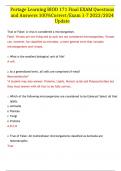 Popular
Popular
-
BIOD 171 Portage Learning Final EXAM Questions and Answers 100%Correct/Exam 1-7 2023/2024 Update
- Exam (elaborations) • 44 pages • 2023 Popular
-
- $20.99
- 5x sold
- + learn more
BIOD 171 Portage Learning Final EXAM Questions and Answers 100%Correct/Exam 1-7 2023/2024 UpdatePortage Learning BIOD 171 Final EXAM Questions and Answers 100%Correct/Exam 1-7 2023/2024 Update True or False: A virus is considered a microorganism. False. Viruses are not living and as such are not considered microorganisms. Viruses can, however, be classified as microbes, a more general term that includes microorganisms and viruses. 1. What is the smallest biological unit of life? A cell. ...
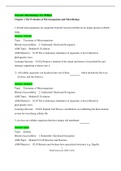
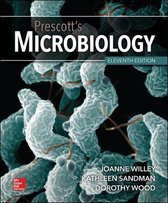
-
Test Bank For Prescotts Microbiology 11th Edition By Willey Chapter 1-43 |Complete Guide A+
- Exam (elaborations) • 1422 pages • 2023
-
- $17.99
- 3x sold
- + learn more
Prescott's Microbiology, 11e (Willey) Chapter 1 The Evolution of Microorganisms and Microbiology 1) Extant microorganisms are organisms from the fossil record that are no longer present on Earth today. Answer: FALSE Topic: Taxonomy of Microorganisms Bloom's/Accessibility: 2. Understand / Keyboard Navigation ASM Topic: Module 01 Evolution ASM Objective: 01.05 The evolutionary relatedness of organisms is best reflected in phylogenetic trees. Learning Outcome: 01.02a Propose a timeline of the ori...
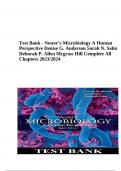
-
Test Bank For Nester’s Microbiology A Human Perspective By Denise G. Anderson Sarah N. Salm Deborah P. Allen Mcgraw Hill Complete All Chapters 2024
- Exam (elaborations) • 847 pages • 2024
-
- $32.49
- 1x sold
- + learn more
Test Bank - Nester’s Microbiology A Human Perspective Denise G. Anderson Sarah N. Salm Deborah P. Allen Mcgraw Hill Complete All Chapters 2024. The scientist usually considered the first to see microorganisms, which he called "animalcules", was A. Redi. B. van Leeuwenhoek. C. Pasteur. D. Tyndall. Bloom's Level: 1. Remember Learning Outcome: 01.01 Section: 01.01 Topic: History of Microbiology Chapter 01 - Humans and the Microbial World 1-2 2. The word "animalcule" was coine...
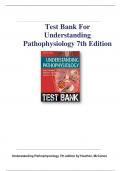
-
Test Bank For Understanding Pathophysiology 7th Edition
- Exam (elaborations) • 849 pages • 2023
-
- $34.69
- 1x sold
- + learn more
Understanding Pathophysiology 7th edition by Huether, McCance Test Bank For Understanding Pathophysiology 7th Edition Test Bank Chapter 1. Cellular Biology MULTIPLE CHOICE 1. A student is observing a cell under the microscope. It is observed to have supercoiled DNAwith histones. Which of the following would also be observed by the student? a. A single circular chromosome b. A nucleus c. Free-floating nuclear material d. No organelles ANS: B The cell described is a eukaryotic ce...
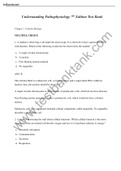
-
Understanding Pathophysiology 7th Edition Test Bank by Sue Huether and Kathryn McCance
- Exam (elaborations) • 770 pages • 2023
-
- $10.99
- 1x sold
- + learn more
Understanding Pathophysiology 7th Edition Test Bank Chapter 1. Cellular Biology MULTIPLE CHOICE 1. A student is observing a cell under the microscope. It is observed to have supercoiled DNA with histones. Which of the following would also be observed by the student? a. A single circular chromosome b. A nucleus c. Free-floating nuclear material d. No organelles ANS: B The cell described is a eukaryotic cell, so it has histones and a supercoiled DNA within its nucleus; thus, the nucleus...
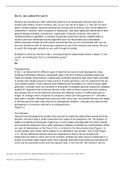
-
Bis 2C, Pre-Lab 2 (Graded A+)
- Exam (elaborations) • 9 pages • 2023
-
Available in package deal
-
- $7.99
- 2x sold
- + learn more
Bis 2C, Pre-Lab #2 Bacteria and Archaea are often collectively referred to as prokaryotes because they lack a nucleus (pro=before, karyon=nucleus). But, as you can see from figure 2.1, they are not each other’s closest relatives. Because bacteria and archaea are so diverse, they can be difficult to characterize. However, when compared to eukaryotes, they have significant differences in their general biology including, reproduction, organization of genetic material, and a lack of membrane...
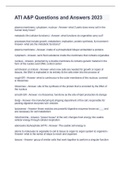
-
ATI A&P Questions and Answers 2023
- Exam (elaborations) • 25 pages • 2023
-
Available in package deal
-
- $10.49
- 2x sold
- + learn more
plasma membrane, cytoplasm, nucleus - Answer- what 3 parts does every cell in the human body have? metabolic life (cellular functions) - Answer- what functions do organelles carry out? processes that include growth, metabolism, replication, protein synthesis, & movement - Answer- what are the metabolic functions? plasma membrane - Answer- made of a phospholipid bilayer embedded w proteins cytoplasm - Answer- semi fluid substance inside the membrane that contains organelles nucleus...
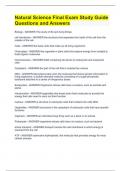
-
Natural Science Final Exam Study Guide Questions and Answers
- Exam (elaborations) • 5 pages • 2024
-
Available in package deal
-
- $10.49
- 1x sold
- + learn more
Biology - ANSWER-The study of life and living things cell membrane - ANSWER-the structure that separates the inside of the cell from the outside of the cell Cells - ANSWER-the basic units that make up all living organisms Chloroplast - ANSWER-the organelle in plant cells that capture energy from sunlight to build organic molecules Chromosomes - ANSWER-DNA containing structures in prokaryotic and eukaryotic cells Cytoplasm - ANSWER-the part of the cell that is outside the nucleus ...
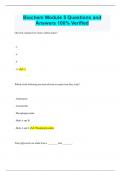
-
Biochem Module 5 Questions and Answers 100% Verified
- Exam (elaborations) • 12 pages • 2023
- Available in package deal
-
- $9.99
- 1x sold
- + learn more
Biochem Module 5 Questions and Answers 100% Verified Glycerol contains how many carbon atoms? - 3 - 4 - 5 - 15 - 3 Which of the following are derived from or made from fatty acids? - Cholesterol - Carotenoids - Phosphoglycerides - Both A and B - Both A and C - Phosphoglycerides Triacylglycerols are made from a ________ and ________. - glycerol; cholesterol Correct! - glycerol; three fatty acids - ceramide; three fatty acids - ceramide; three cholesterols - carotenoid; two cholester...
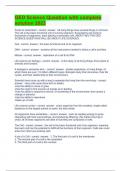
-
GED Science Question with complete solution 2023
- Exam (elaborations) • 10 pages • 2023
-
Available in package deal
-
- $17.49
- 1x sold
- + learn more
GED Science Question with complete solution 2023Points to remember! All living things have several things in common. The cell is the basic functional unit of a living organism. Ecosystems are home to thousands of organisms, each playing a necessary role. ABOUT 40% THE GED SCIENCE QUESTIONS WILL BE ABOUT LIFE SCIENCES. Cell the basic functional unit of an organism DNA contains all the instructions needed to direct a cell's activities Mitosis replication of a cell & its D...



